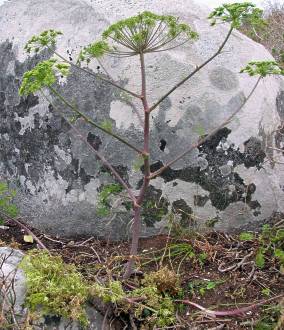Cynorhiza typica
Cynorhiza typica Eckl. & Zeyh.
Family: Apiaceae
Common names: bierwortel, gatagaai, hondewortel (Afr.)
Introduction
Cynorhiza typica is a striking wild carrot, the root of which was once commonly used in the West Coast region of the Cape to brew an intoxicating honey beer.

Description
Description
Cynorhiza typica is a summer-deciduous, perennial herb. The compound leaves are arranged in a basal tuft, often creeping or scrambling, and are deciduous during or soon after flowering. The flowers are small and yellow and arranged in very large, rounded, compound umbels with up to 78 rays borne on a very tall peduncle of up to 1.5m. The fruit is large and dry and dorsally flattened with very broad thin wings along the margins.

Flowering time is from October to January.

Conservation Status
Status
Least Concern (LC).
Distribution and habitat
Distribution description
The species has a highly disjunct distribution. In its eastern range, from Graaff-Reinet to Port Alfred, it usually occurs in dense succulent thicket or coastal scrub, while in its western range, from Koeberg to the Richtersveld, it occurs in dense Strandveld along the coast or occasionally more inland in Succulent Karoo vegetation on the Kamiesberg and in the Richtersveld.
Derivation of name and historical aspects
History
Cynorhiza Eckl. & Zeyh. is a genus of perennial, summer-deciduous herbs endemic to South Africa. The name is derived from the Afrikaans vernacular name, hondewortel ('dog-root'), for Cynorhiza typica Eckl. & Zeyh. (Smith 1966).
The genus had been considered congeneric to Peucedanum L. since Sonder (1862) but has subsequently been shown to be distinct (Winter et al. 2008). The latest treatment of the genus, Magee et al. (2008), recognizes three species two of which are newly included. The one, C. meifolia (Eckl. & Zeyh.) Magee had had been previously misplaced in Peucedanum L., and the other, C. bolusii Magee & B.-E.van Wyk is a newly described species from around Ceres.
Previously the western and eastern populations of C. typica had been treated as two distinct species, viz. Peucedanum typica in the Eastern Cape and P. sulcatum in the Western and Northern Cape. However, Magee et al. (2008) argued that there was a clear overlap in all diagnostic characters and so recognized them as two population groups of a single variable species, viz. Cynorhiza typica.
Ecology
Ecology
The plants are summer-deciduous and form new leaves annually in the wet winter months. Their flowers are borne in spring, at which time the leaves have already begun to shrivel and die so that the plants are leafless by the time fruits are present in summer.
The leaves are adapted to climb or scramble up into the dense surrounding vegetation and continue to grow throughout the growing season, so that they may become up to 1.5 m long (Magee et al. 2008).
Uses
Use
As suggested by the common name bierwortel, the root of Cynorhiza typica was once traditionally used to brew mead or honey beer in the Western Cape Province. Van Wyk & Gericke (2000) outline the only recorded information about the process, as provided to them by Dawid Bester. The root of the plant is sliced into 10 mm thick segments and left in the sun to dry. Once dry, the segments take on a distinctly yellow-orange colour and the inner pith is removed from the shrunken outer cortex and discarded. The dry outer cortex is then finely ground and together with some honeycomb (containing bee embryos) added to the water. The mixture is then allowed to ferment before drinking, producing a potent traditional mead that can cause a terrible hangover the next day.

Growing Cynorhiza typica
Grow
Specific information regarding the cultivation of C. typica is currently unavailable. The plant would make a striking addition to a garden with its large, multiradiate compound umbels overtopping a dense stand of shrubs. The inflorescence makes a great structural feature in spring and becomes even more attractive when the large, often red-tinged fruit are borne in summer. When dry, the inflorescence can be cut right back to the ground. The species is ideal for coastal gardens and should be kept dry in summer.

References
- Magee, A.R., Van Wyk, B.-E. & Tilney, P.M. 2008. A taxonomic revision of the genus Cynorhiza (Apiaceae: Apioideae). South African Journal of Botany 74, 4: 726-734.
- Smith, C.A. 1966. Common names of South African plants. Memoirs of the Botanical Survey of South Africa No. 35. Department of Agricultural Technical Services, Pretoria.
- Sonder, O.W. 1862. Umbelliferae. Pp. 524-567 in Flora Capensis 2, Harvey, W.H. & Sonder, O.W. (eds). Hodges Smith, Dublin.
- Van Wyk, B.-E. & Gericke, N. 2000. People's plants: A guide to the useful plants of southern Africa. Briza Publications, Pretoria.
- Winter, P.J.D., Magee, A.R., Phephu, N., Tilney, P.M., Downie, S.R. & Van Wyk, B.-E. 2008. A new generic classification for African peucedanoid species (Apiaceae). Taxon 57, 2: 347-364.
Credits
Anthony R. Magee
Compton Herbarium
June 2011
Plant Attributes:
Plant Type: Perennial, Scrambler
SA Distribution: Eastern Cape, Northern Cape, Western Cape
Soil type: Sandy
Flowering season: Spring, Early Summer
PH: Acid
Flower colour: Yellow
Aspect: Full Sun, Afternoon Sun (Semi Shade)
Gardening skill: Easy
Special Features:
Horticultural zones










Rate this article
Article well written and informative
Rate this plant
Is this an interesting plant?
Login to add your Comment
Back to topNot registered yet? Click here to register.